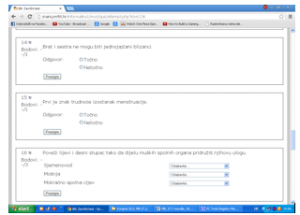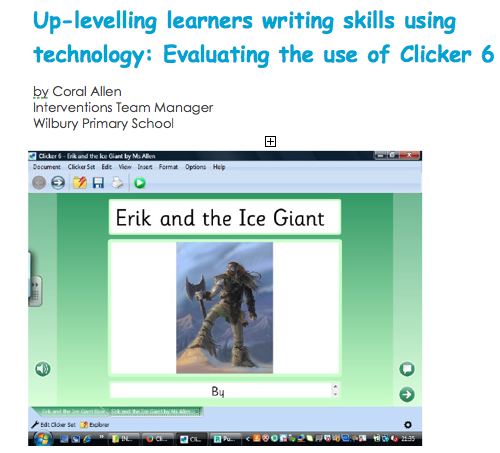by Mila Bulić and Daniela Novoselić
A modern man of the 21st century should, in addition to traditional language skills, possess a wealth of knowledge, environmental, health, economic, social and computer skills in order to lead a high-quality lifestyle. As our students are a part of a digital society with access to a wide range of information provided using information and communication technology (ICT), it is important to include ICT in the educational process as well. In order to make this possible, schools should not only have the necessary infrastructure and adequate space, but also computer literate teachers who are able to create diverse teaching scenarios and use ICT in the classroom. In Croatia there are few individual examples of good practice in using e-learning in teaching science, therefore teachers should be made aware of the possibility of using modern technology in class, as well as being additionally educated through professional training.
Moodle and Biology
The e-learning project using the Moodle system (a free web application for on-line learning) began with the development of the digital materials necessary for teaching the Body composition, reproduction and development unit for the 8th grade of elementary school biology classes. Various additional practice materials as well as quizzes designed to test the students’ acquired knowledge were developed to be used after finishing each of the four lessons: Structure and function of sexual organs, Conception and development before birth, Life periods of human life and Responsible sexual behavior. Through Moodle the teacher monitored each of the students’ logins, his or her work on the given lesson, forum and discussions activity and quiz results.
Twenty-four students participated in the e-learning project. They were all eighth-graders attending the Pujanka Elementary School in Split, Croatia. The project was conducted at the beginning of the spring semester, in the school year 2012 – 2013. The 24 selected students made up the experimental group which learnt using the digital materials on Moodle on computers in the school’s IT lab. At the same time, the biology teacher taught the same unit to another group of 24 eighth-graders attending the same school (A control group), using the traditional teaching approaches and various knowledge sources, as well as various teaching methods.
The digital teaching materials on Moodle were arranged in a way to ensure a simple and user friendly interface for the students (Figure 1).
Figure 1. User interface on the Moodle index
Before the e-learning project began, the students had been introduced to the Moodle interface and an e-mail address had been given to them by the biology teacher in case any of the students needed additional help resolving problems or ambiguities. Students also had the opportunity to ask questions on the News Forum available to all users. It was interesting to notice that the students preferred to ask for help individually via e-mail rather than using the forum, which confirms their unwillingness to publicly share their own thoughts, questions and problems.
To ensure that the student’s were independent and given thorough e-learning, the materials were divided into smaller units listed in the Lesson menu, located on the left side of the user interface. The students accessed these units by simply selecting the desired topic. Also, various audiovisual and visual sources, pictures, illustrations, graphs, 3D models, videos and animations were added to the textual materials (Figure 2).
Figure 2. A Moodle page containing educational materials and a video
Various practice materials were available at the end of each lesson. At the end of the unit the students took a quiz that included different types of tasks (Figure 3) such as matching short answers, true/false questions, matching pairs, multiple choice, embedded answers, short answers and calculation tasks.
As the objective of this project was to determine the efficiency of e-learning compared to traditional teaching, at the end of the Body composition, reproduction and development unit the acquired knowledge was tested both in the control group, taught in a traditional classroom, as well as in the experimental group, taught through e-learning. The results of the test were compared and all students were surveyed about the learning methods they used.
The survey shows that students are satisfied and have positive feelings toward e-learning, as the mean value of 80% of the answers given to statements are above 4,5 showing complete student satisfaction with using e-learning in a biology class. The students pointed out that the textual and visual descriptions were highly helpful during the learning process, but they were also aware of the additional effort needed for successful e-learning. Namely the experimental group’s quiz results were not significantly better than the control groups’ results. However, students’ satisfaction with the learning process itself should certainly be a source of motivation for teachers.
Figure 3. The Moodle quiz page designed to test acquired knowledge
These already designed and implemented e-learning projects should be a motivation for teachers to continue creating digital teaching materials and various digital activities which will ensure that students develop skills allowing them to recognize and solve real life problems concerning health and sustainability.
AUTHORS
 Mila Bulić (1970.) is a biology and chemistry teacher. She is working at Primary school and at the Faculty of Philosophy in Split (Croatia), where she works with future teachers and teach them methods of work in the classroom. She is the author of numerous published scientific papers and school biology and chemistry texbooks for Primary school and Gymnasium. Her interest areas are sustainable development, health and e-learning.
Mila Bulić (1970.) is a biology and chemistry teacher. She is working at Primary school and at the Faculty of Philosophy in Split (Croatia), where she works with future teachers and teach them methods of work in the classroom. She is the author of numerous published scientific papers and school biology and chemistry texbooks for Primary school and Gymnasium. Her interest areas are sustainable development, health and e-learning.
 Daniela Novoselić (1964.) is a biology and chemistry teacher with over 15 years of experience working in schools. She has taught in middle schools, high schools and universities, including the department of biology at the Faculty of science in Osijek (Croatia), and is the author of numerous published scientific papers. She currently works as the author and editor of school biology and chemistry texbooks for a Croatian publishing house, Alfa dd., in Zagreb. Through her work she aims to better the teaching strategies used in Croatian schools.
Daniela Novoselić (1964.) is a biology and chemistry teacher with over 15 years of experience working in schools. She has taught in middle schools, high schools and universities, including the department of biology at the Faculty of science in Osijek (Croatia), and is the author of numerous published scientific papers. She currently works as the author and editor of school biology and chemistry texbooks for a Croatian publishing house, Alfa dd., in Zagreb. Through her work she aims to better the teaching strategies used in Croatian schools.

















